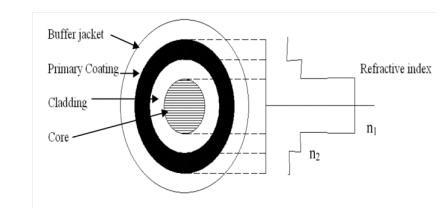Chapter: Fiber optics and Laser instruments : Optical Fiber and Their Properties
Different types of fibers and their properties
Different types of fibers and
their properties

GLASS AND PLASTIC FIBERS
Based on
materials in which the fibers are made it is classified into two types as
follows:
Glass fibers
If the
fibers are made up of mixture of metal oxides and silica glasses are called
glass fibers.Examples:-
(i) Core: SiO2;cladding: P2O3– SiO2
(ii) Core: GeO2– SiO2;cladding: SiO2
Plastic fibers
If the
fibers are made up plastics which can be handled without any care due to its
toughness and durability it is called plastic fiber.
Examples:-
The
plastic fibers are made by any one of the following combinations of core and
cladding.
1. Core:Polymethylmethacrylate;
cladding: co-polymer
2. Core:
Polystyrene; cladding: Methyl methacrylate
1. Single and multimode fibers
Mode is
described by the nature of propagation of electromagnetic waves in a wave
guide. Based on the modes of propagation the fibers are classified into two
types viz.
(i) Single mode fibers
(ii) Multi mode fibers
(i) Single mode fibers
1. It has
very small core diameter so that it can allow only one mode of propagation and
hence called single mode fibers.
2. The
cladding diameter must be very large compared to the core diameter.
3. Thus in
the case of a single mode fiber, the optical loss is very much reduced.
Structure
Core
diameter: 5 – 10 μm
Cladding
diameter : Around 125 μm
Protective
layer: 250 to 1000 μm
Numerical
aperture: 0.08 to 0.10
Band
width: More than 50 MHz km

(ii) Multi-mode fibers:
1. Here
the optical dispersion may occur.
2. They
are made by multi-component glass materials.
3. The
core diameter is larger than the diameter of the single mode fibers, so that it
can allow many modes to propagate through it and hence called as multimode
fibers.
Structure:
Core
diameter:50 – 350 μm
Cladding
diameter: 125 – 500 μm
Protective
layer: 250 to 1100 μm
Numerical
aperture: 0.12 to 0.5
Band
width:Less than 50 MHz km

2.Step index and graded index
fibers:-
Based on
the variation in the refractive index of the core and the cladding, the fibers
are classified into two types, viz.
(i) Step index fiber
(ii) Graded index fiber
STEP INDEX FIBER
Here the
refractive indices of air, cladding and core vary step by step and hence it is
called as step index fiber.Thereare two types of step index fibers. They are,
1. Step
index single mode fiber –there is dispersion will occur.
2. Step
index multi modefiber -- there is
intermodal dispersion will occur.

GRADED
INDEX FIBER
Here the refractive index of the core varies
radically from the axis of the fiber. The refractive index of the core is large
along the fiber axis and it’s gradually decreases thus it is called as graded
index fiber.
Here the
refractive index becomes small at the core – cladding interface. In general the
graded index fibers will be of multimode system. The multimode graded index
fiber has very less intermodal dispersion compared to multimode step index
fiber.
Related Topics